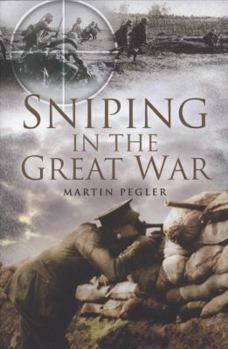Sniping in the Great War
Select Format
Select Condition 
Book Overview
Military snipers are highly trained marksmen who target individual enemy soldiers. They are regarded as vital specialists in modern warfare, and their role evolved throughout the Great War. As Martin Pegler shows in this wide-ranging, authoritative study, the technique of sniping adapted rapidly to the conditions of static warfare that prevailed through much of the conflict.
His account follows the development of sniping from the early battles of 1914, through the trench fighting and the attributional offensives of the middle years, to the renewed open warfare of 1918. He concentrates on the continuous British and German sniping war on the Western Front, but he also looks at how snipers operated in other theaters, at Gallipoli and Salonika and on the Eastern Front. Sniper training, field craft and counter-sniping measures are described in detail.
There is a full reference section giving the specification of the sniping rifles of the period and assessing their effectiveness in combat. Also featured are vivid memoirs and eyewitness accounts that offer a fascinating insight into the lethal skill of Great War snipers and their deadly trade.
His account follows the development of sniping from the early battles of 1914, through the trench fighting and the attributional offensives of the middle years, to the renewed open warfare of 1918. He concentrates on the continuous British and German sniping war on the Western Front, but he also looks at how snipers operated in other theaters, at Gallipoli and Salonika and on the Eastern Front. Sniper training, field craft and counter-sniping measures are described in detail.
There is a full reference section giving the specification of the sniping rifles of the period and assessing their effectiveness in combat. Also featured are vivid memoirs and eyewitness accounts that offer a fascinating insight into the lethal skill of Great War snipers and their deadly trade.
Format:Hardcover
Language:English
ISBN:1844157555
ISBN13:9781844157556
Release Date:October 2008
Publisher:Pen & Sword Books
Length:212 Pages
Weight:0.75 lbs.
Dimensions:0.9" x 6.4" x 9.5"
Customer Reviews
2 ratings
Great Buy
Published by Thriftbooks.com User , 14 years ago
Great book, arrived quickly and was in great condition for it being a used book.
How The Wheel Was Re-invented
Published by Thriftbooks.com User , 16 years ago
Martin Pegler's books on sniping never fail to be interesting. He is a knowlegeable writer on the subject which obviously fascinates him. World War 1 was by its nature a snipers war for most of its duration. A static front with little room to move lent itself to sniping. The German forces understood this and was ready, the Allies were not. This book is how the Allies, through the efforts of a few motivated officers, corrected the situation and eventually reversed the tables on the Germans. Pegler does not restrict his narrative to the Western Front but also reviews the Gallipoli campaign and the war in Palestine and Macedonia. He notes that Gallipoli was nearly entirely a snipers war fought with open sights and at quite close ranges. He notes the skill that the Turkish snipers had and how on the Allies side it was the Australian and New Zealand soldiers who had been civilian hunters who were able to counter the threat. A fascinating side to the book is the distaste for snipers by their fellow soldiers and especially high ranking officers but that when a unit was being pinned down by enemy snipers it was their own that they first turned to. Undoubtedly it was the distaste for the sniper that led to their skills being allowed to lapse as soon as the conflict was ended. Something that Pegler has noted in other books he has written because the same thing was to happen at the end of the Second World War and the Korean War. Altogether, this is a worthwhile addition to any military library although a well-read reader will find many well-known references from other books on the subject.






